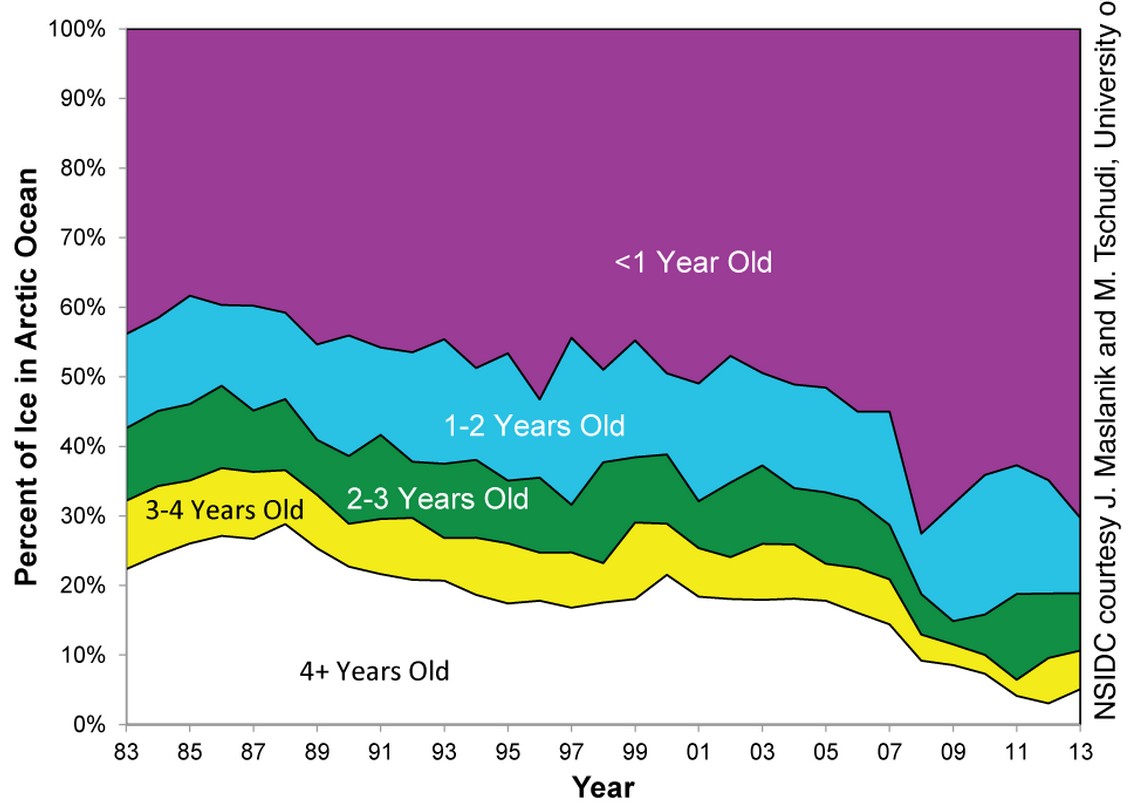PIOMAS claims that Arctic ice is thinning, but they are wrong. There is more 2+ year old ice than four years ago. There is more 3+ year old ice than two years ago, and there is more 4+ year old ice than last year.
Bottom line is that the Arctic is rapidly returning to pre-2007 conditions. Very bad news for the team.
Arctic Sea Ice News and Analysis | Sea ice data updated daily with one-day lag



Maybe the levels seen in recent years is actually where it spends most of its time. Who could possibly tell what extent/volume it is “supposed to be”?
The oldest ice now comprises only 5% of the ice in the Arctic Ocean. This is a slight uptick from last winter’s record low of 3%, but still far less than during the 1980s when old ice covered roughly 25% of the region.
The ASCAT data and ice age data both suggest a continued thinning of the ice pack, and overall decline in its volume, but they do not provide direct information on ice thickness. However, the European Space Agency’s CryoSat-2 satellite, launched in April 2010, now provides estimates of sea ice thickness distribution across the Arctic Ocean. A new paper by Laxon et al. (2013) shows the first published results from CryoSat-2 and compares them with thickness estimates from NASA’s ICESat satellite, which operated from 2003 to 2009. The CryoSat-2 results indicate continued thinning since 2008. Significantly, ice along the north coast of Greenland appears to have thinned—in the past this has been the site of some of the thickest sea ice in the Arctic. The paper also shows that total volume estimates from CryoSat-2 agree well with University of Washington’s Pan-Arctic Ice Ocean Modeling and Assimilation System (PIOMAS) estimates.http://nsidc.org/arcticseaicenews/
And how does thickness compare to the satellite estimates of 15,000 years ago?
Is Laz the liar bored with his own obsessive website again? Tired of boiling bunnies? 😆
How about handing over that proof that Steven is receiving funding from fossil fuel interests?
What a stooge! 😆
That graph doesn’t show absolute area of ice. It only shows the relative percentage of ice in each category (1 year ice, et cetera.) Doesn’t show what you’re claiming. It also shows that the share of 1 year old ice has increased over the last 30 years, from about 45% to about 65%.
DOH Homer. The area of ice this time of year hardly varies, and is actually higher now than it was a few years ago – which strengthens my argument even further.
I wonder if Gina ever tires of being wrong.
What was ice like in the 1930’s and 1940’s? We all know that the late 70’s into early 80’s was an exceptionally cold period. To say that today’s ice is less than the coldest period on record does not prove very much
This 1906 book is full of broken ice, during a time when T.O.O and Gina know there was no broken ice. Its a free book T.O.O. Download and read it, then discard it all as anecdote. Because the author knew there was going to be global warming way back then, and planted a false narrative just so we would be thrown off track today.
“Conquering the Arctic Ice”, Ejnar Mikkelsen, 1906.
http://goo.gl/VHe8f
“On October 28 I took a long walk on the ice to the north of the island to see what it looked like It was rather heavy walking and I made up my mind that if it did not change we should have to hew a road through it when we started northward but it might be better further out Some pieces of old ice had grounded about a mile from the shore and binding the young ice inside made rather a good floe But further outside large and heavy pieces of old ice had become frozen together and from the top of a large piece about 25 feet high nothing but a surface of broken ice was visible “
Gard, G. (1993). Later Quaternary coccoliths at the North Pole: Evidence of ice-free conditions and rapid sedimentation in the central Arctic Ocean. Geology. 21, 227-230